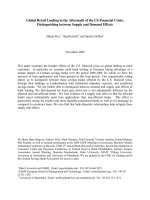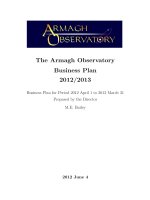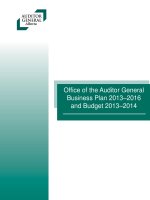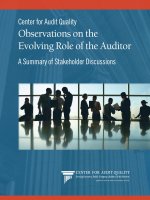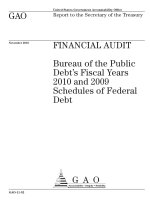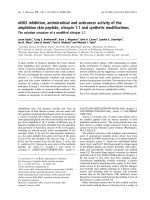Offi ce of the Auditor General Business Plan 2013–2016 and Budget 2013–2014 pot
Bạn đang xem bản rút gọn của tài liệu. Xem và tải ngay bản đầy đủ của tài liệu tại đây (215.2 KB, 18 trang )
Offi ce of the Auditor General
Business Plan 2013–2016
and Budget 2013–2014
Offi ce of the Auditor General
Business Plan 2013–2016
Office of the Auditor General Business Plan 2013–2016
1
The Office
The Office of the Auditor General serves the Legislative Assembly and the people of Alberta. Our
mandate is to examine and report publicly on government’s management of, and accountability
practices for, the public resources entrusted to it. Under the Auditor General Act, the Auditor General
is the auditor of all government ministries, departments, funds and provincial agencies.
We focus our priorities and resources to improve:
• government and ethical behavior—these underpim the success of any organization
• safety and welfare of all Albertans—especially the most vulnerable in our society
• security and use of the province’s resources—they belong to all Albertans and must be
protected
To succeed, we must be, and be seen to be, independent and accountable.
Independence
Our independence from those we audit ensures our work is objective—based on facts, not
preconceived opinions. The independence requirement is symbolized through the appointment of the
Auditor General by the Legislative Assembly and our liaison with the Assembly through the Standing
Committee on Legislative Offices. A primary element of the relationship is the Assembly’s
prerogative to authorize financing of the Office’s operations.
Our business practices are designed to ensure that our staff remains free of any association that could
potentially impair their objectivity.
Accountability
We are accountable for our responsibilities under the Auditor General Act through our public reports,
the tangible expressions of our work. Those who use public resources, as we do, should also
demonstrate their accountability through clear and concise plans and reports on results.
The first part of accountability is preparing and then acting on a plan; hence this business plan. It
guides us in meeting our mandate and showing accountability through relevant audits, reliable
findings, and reasonable costs.
The second part of accountability is reporting on results and costs in relation to the plan and on how
performance can improve. Our last performance report was made public on June 28, 2012
1
.
1
Auditor General of Alberta, Results Analysis, Financial Statements, and Other Performance Information for
the Year Ended March 31, 2012
Office of the Auditor General Business Plan 2013–2016
2
We carry out our work using our vision, mission, and values.
Vision
Adding value through expert auditing.
Mission
To serve Albertans by conducting comprehensive risk-based audits that provide independent
assessments to help the Legislative Assembly hold government accountable.
Values
• Respect—Everyone has the right to be heard and deserves to be treated with dignity and
courtesy.
• Trust—We earn it with everything that we say and do. We are accountable for our actions.
• Teamwork—With integrity, we work together to generate better solutions.
• Growth—We view individual success as professional growth together with a fulfilling personal
life. We value both.
Core business
Our core business is legislative auditing. We have six lines of interrelated but different types of audit
work, so we can allocate resources and assess our performance. We are the auditor of every ministry,
department, regulated fund, and provincial agency. This responsibility includes universities, colleges,
and Alberta Health Services. In all, we are the auditor of about 175 entities.
The six lines of auditing
1. Financial statements
Every year we audit the financial statements of those entities for which we have been appointed
auditor, including the consolidated financial statements of the Government of Alberta. Our
auditor’s report on each of these entities provides our opinion on whether the financial
statements are presented fairly in accordance with appropriate standards. These recurring annual
audits provide assurance on the quality of financial reporting to the Legislative Assembly.
2. Compliance with laws
A variety of rules in statutes, regulations, central agency directives and policies, and
departmental procedures govern the proper conduct of government. In all our audits, we test
transactions and activities to identify and report publicly if there has been non-compliance with
the law. Compliance with laws, regulations, and other rules is an important part of assessing
accountability.
Office of the Auditor General Business Plan 2013–2016
3
3. Performance measures
For departments and some agencies, we review selected non-financial performance measures in
the entity’s annual report. And we audit selected measures in the annual progress report on the
government’s business plan, titled Measuring Up. We report on the reliability,
understandability, comparability, and completeness of the selected performance measures. But
our work is not designed to provide assurance on the relevance of the measures to users.
4. Results analysis
Each ministry annual report contains a results analysis. Essentially, management’s purpose is to
integrate the financial and non-financial performance information into a clear and concise
interpretation of actual performance in relation to plans. We are considering how we can add
credibility to management’s results analysis.
5. Systems
Sections 19(2)(d) and (e) of the Auditor General Act require us to report when “accounting
systems and management control systems, including those systems designed to ensure economy
and efficiency, …were not in existence, were inadequate or had not been complied with” or
“when appropriate and reasonable procedures could have been used to measure and report on
the effectiveness of programs, those procedures were either not established or not being
complied with”. We meet this expectation in two ways:
• Stand-alone audits—We audit major programs or initiatives that an organization
undertakes to achieve its goals. In a stand-alone systems audit, we answer the question,
“Does the organization have the policies, processes, and controls to accomplish its goals
and mitigate its risks economically and efficiently?” Such systems include procedures to
measure and report on the effectiveness of programs.
• By-products of other audits—If we find that an organization could improve its systems
in areas such as governance and accountability, internal control over financial
management, information technology, or performance reporting, we make
recommendations to management.
6. Research and advice
We decide what work to perform based on input from Members of the Legislative Assembly,
Albertans who contact us, management, and staff. Annually, we also receive advice from the
Provincial Audit Committee. Often this input requires research to understand the issue or to
identify best practices. Alternatively, at the request of an organization that we audit, or a
committee of the Legislative Assembly, we may give advice on a proposed course of action or a
matter being studied.
Office of the Auditor General Business Plan 2013–2016
4
Goal, risks, strategies, performance measures and key initiatives
Last fiscal year, we involved all staff levels in our risk management process. Then we used the results
to drive our business planning. The integrated business cycle has these elements:
Elements of the business cycle
1. Goal
Our vision is to add value through expert auditing, so our goal is to maximize relevance within
the constraints of reliability and reasonable cost.
An important consideration is that we identify the root causes of weak systems recognizing that
management owns the systems.
2. Risk management
Our audits must be:
• Relevant—Our work must be relevant to the Legislative Assembly and Albertans.
• Reliable—The Legislative Assembly and Albertans must be able to count on our work.
• Reasonable cost—We must meet cost challenges in producing relevant and reliable
reports.
Operationally, we must manage:
• Input risk—Do the skills of our staff, and agents and contracted experts, match the audit
risk in our six lines of auditing?
•
Process risk—Is our audit project management effective?
•
Output risk—Have we maintained independence and objectivity?
Office of the Auditor General Business Plan 2013–2016
5
3. Strategies
• Spread oversight of systems audit projects among the four audit division Assistant
Auditors General.
•
Build our capacity to do systems audits by freeing up staff from financial statement
audits. This requires the following improved efficiencies in doing our work:
- Challenge junior staff to do more complex work earlier, with proper supervision, so
they can develop. This will help free up senior staff to undertake more system audit
projects
- Redefine the roles and expectations of our external agents doing audit work for the
Office
-
Retain specialist audit staff for more complex audit projects
-
Improve training of audit staff so they can do both systems and financial statement
audits
- Use findings from an external independent peer review to improve current audit
and operational processes.
- Use our internal sector auditing partnerships to assist in deciding on priority systems
audits
•
Review our optimal staff mix:
- Type: use of internal staff versus temporary or agent resources
- Level: introduction of accounting technicians
-
Mix: challenge lower staff levels to do more complex work in financial statement
audits
•
Decrease the backlog of follow-up audits in order to deliver more new systems audit
projects
4. Performance measures and accountability reporting
As our business plan 2012–2015 described, all staff helped review our risk management
process. One key deliverable was a review of our performance measures to ensure they help us
and our stakeholders (MLAs, government and our staff) understand our performance—key in
showing accountability. The risk management review helped us confirm, refine or develop
21 measures—8 external and 13 internal. Annually, we will continue to review performance
measures for external reporting. For example, peer review will be an external measure in the
next business plan, as the information will then be available.
Priority initiatives
1. Results analysis project
We will conduct a stand-alone systems audit of the processes used by ministries to prepare
results analysis sections in ministry annual reports. We view this as a prerequisite to the
potential development of a methodology to provide assurance, in relation to appropriate criteria,
on management’s analysis of performance.
Office of the Auditor General Business Plan 2013–2016
6
2. Independent peer review
We will continue to execute our plan to be ready for an independent peer review. The review
will be commissioned to provide conclusions on whether we do relevant, reliable work at a
reasonable cost, and will be made public. The external peer review will report on the Office’s
operational design of our systems in July 2013 and operating effectiveness of our systems in
July 2014.
3. Staff development
Creating an organization that thrives in dealing with challenges and new initiatives, while
delivering extraordinary performance to all our stakeholders, is our aim. We draw on the
potential in every employee. Success is more likely if we accelerate challenging opportunities
and improve training and mentoring for all staff. In 2013–2014, we will ensure our training
program continues to improve the overall effectiveness, efficiency and personal excellence of
all staff.
4. Outstanding recommendations
As we outlined in the Report of the Auditor General of Alberta—October 2012, there are
165 outstanding numbered recommendations. Numbered recommendations require a formal
public response from the government. It is our intention to focus on the 25 numbered
recommendations more than three years old that departments or agencies have notified us are
ready for follow-up audits. These follow-up audits will be completed prior to December 2013.
The recommendations include a cross-section of important services such as food safety, seniors
care, post-secondary institutions, school boards, infrastructure needs, and sand and gravel
resources.
Office of the Auditor General Business Plan 2013–2016
7
External performance measures
Relevant auditing
Target
2013–2014
Target
2012–2013
Actual
2011–2012
1.a Percentage of the Auditor General’s
recommendations accepted
1
(also Reliable)
95%
95% 100%
1.b Auditor General’s recommendations not implemented
within three years of acceptance
None None 42
1.c Issue our auditor’s report on the consolidated
financial statements of the Province by June 30
each year
June 30,
2013
June 21,
2012
(Actual)
June 23,
2011
1.d Percentage of costs dedicated to systems
auditing/other auditing (also Reasonable cost)
22/78% 20/80% 21/79%
1.e Percentage of Members of the Legislative Assembly
who believe our work is valuable
2
(also Reliable)
To be
decided
Not
conducted
Inadequate
response rate
to draw
conclusion
Reliable auditing
Target
2013–2014
Target
2012–2013
Actual
2011–2012
2.a Institute of Chartered Accountants of Alberta’s
conclusion that Office’s financial statements audit
practice meets auditing standards
3
(also Relevant and
Reasonable Cost)
Will not
be done
Met
Not
done
Reasonable cost auditing
Target
2013–2014
Target
2012–2013
Actual
2011–2012
3.a
Staff turnover rate
4
(also Reliable)
Under 20% Under 20% 22%
3.b Percentage of financial statement audits completed
within budget
90% 90%
New
measure
_______ ____________ ____________ ____________ ____________ ____________ ____________ ____________ ____________ ______
1
Acceptance does not include recommendations accepted in principle or under review.
2
This survey was done in 2012 with a response rate of 23 out of 83 MLAs or 28%. The next survey will be in 2014–2015.
3
The practice review is done triennially. The next one will be completed in 2015–2016.
4
Turnover rate includes voluntary and involuntary vacancies that affect our productivity and cost.
Office of the Auditor General
Budget 2013–2014
OFFICE OF THE AUDITOR GENERAL OF ALBERTA
BUDGET BY OBJECT
(thousands of dollars)
2013–2014
2014–2015
2015–2016
Budget Actual
Budget
Forecast Estimate Target Target
EXPENSE
Personnel
Salaries and wages 12,905$ 12,841$ 13,895$ 13,670$ 14,580$ 15,015$ 15,465$
Agent and other audit services fees 4,575 4,417 4,575 4,575 4,380 4,510 4,645
Employer contributions 2,535 2,649 3,050 3,095
3,285
3,380 3,485
Temporary staff services 1,300 1,700 1,470 1,410 1,350 1,350 1,350
Advisory services 220 257 220 325 265 245 245
Miscellaneous 10 - 10 10 10 10 10
21,545 21,864 23,220 23,085 23,870 24,510 25,200
Supplies and services
Training and professional fees 850 778
805
805 825
825 835
Travel 580 605
560
600
570
580 585
Technology services 335 322
420
420 430
430 435
Materials and supplies 180 176
195
195 200
200 200
Telephone and communications 80 83
80
85 85
85 85
Rental of office equipment 70 66
70
50 50
50 50
Repairs and maintenance 20 22
25
25 25
25
25
Miscellaneous 30 18
20
20 20 20 20
2,145 2,070 2,175 2,200 2,205 2,215 2,235
VOTED OPERATING EXPENSE
23,690 23,934 25,395 25,285 26,075 26,725 27,435
Add: amortization of capital assets (non-voted) 295 275
290
330 295 380 370
Total operating expenses 23,985 24,209 25,685 25,615 26,370 27,105 27,805
Less: audit fee revenue (non-voted) (2,300) (2,924)
(2,300)
(2,350) (2,450) (2,520) (2,595)
budget encumbrance from 2011 – 12
- -
(94)
- - - -
Cost of operations 21,685$ 21,285$ 23,291$ 23,265$ 23,920$ 24,585$ 25,210$
VOTED CAPITAL INVESTMENT 155$ 5$ 255$ 270$ 560$ 255$ 260$
TOTAL VOTED EXPENSE AND CAPITAL 23,845$ 23,939$ 25,650$ 25,555$ 26,635$ 26,980$ 27,695$
OPERATING EXPENSE BY CORE BUSINESS
(Includes amortization of capital assets)
Systems audits
1
4,395$ 5,097$ 5,280$ 5,975$ 5,885$ 5,965$ 6,115$
Other audits
2
19,590 19,112 20,405 19,640 20,485 21,140 21,690
23,985$ 24,209$ 25,685$ 25,615$ 26,370$ 27,105$ 27,805$
1
Systems audits are audits of major programs or initiatives an organization undertakes to achieve its goals.
2
Other audits comprises auditing of financial statements, compliance with authorities, performance measures, results analysis, and
research/advice.
Comparable
2011–2012
Comparable
2012–2013
Schedule 1
2012 Actual 2013 Forecast 2014 Estimates
Systems
Audits
2
Other
Audits
3
Total
Systems
Audits
Other
Audits
Total
Systems
Audits
Other
Audits
Total
Alberta's Economic Future
Aboriginal Relations $ 230,000 $ 50,000 $ 280,000 $ 183,000 $ 58,000 $ 241,000 $ 521,000 $ 82,000 $ 603,000
Agriculture and Rural Development
111,000 791,000 902,000 94,000 713,000 807,000 10,000 707,000 717,000
Enterprise and Advanced Education
554,000 4,661,000 5,215,000 867,000 4,638,000 5,505,000 462,000 4,764,000 5,226,000
Infrastructure
6,000 225,000 231,000 15,000 222,000 237,000 180,000 221,000 401,000
14,000 118,000 132,000 27,000 69,000 96,000 - 53,000 53,000
Tourism, Parks and Recreation
- 173,000 173,000 - 197,000 197,000 - 248,000 248,000
915,000 6,018,000 6,933,000 1,186,000 5,897,000 7,083,000 1,173,000 6,075,000 7,248,000
Families and Communities
Culture - 133,000
133,000
- 169,000
169,000
- 188,000
188,000
Education 10,000 498,000
508,000
160,000 592,000
752,000
387,000 577,000
964,000
Health 951,000 2,630,000
3,581,000
1,207,000 2,570,000
3,777,000
1,189,000 2,442,000
3,631,000
Human Services 1,234,000 2,105,000
3,339,000
517,000 1,997,000
2,514,000
52,000 1,987,000
2,039,000
Justice and Solicitor General 25,000 433,000
458,000
1,000 470,000
471,000
201,000 469,000
670,000
Service Alberta 231,000 621,000
852,000
242,000 813,000
1,055,000
329,000 818,000
1,147,000
2,451,000 6,420,000 8,871,000 2,127,000 6,611,000 8,738,000 2,158,000 6,481,000 8,639,000
Resource Stewardship
Energy
81,000 800,000
881,000
127,000 855,000
982,000
257,000 1,017,000
1,274,000
698,000 670,000
1,368,000
936,000 773,000
1,709,000
744,000 982,000
1,726,000
Municipal Affairs 90,000 542,000
632,000
333,000 478,000
811,000
105,000 496,000
601,000
Transportation 460,000 242,000
702,000
312,000 217,000
529,000
- 233,000
233,000
Treasury Board and Finance 402,000 4,132,000
4,534,000
913,000 4,494,000
5,407,000
1,281,000 4,862,000
6,143,000
1,731,000 6,386,000 8,117,000 2,621,000 6,817,000 9,438,000 2,387,000 7,590,000 9,977,000
Executive Council - 78,000
78,000
40,000 88,000
128,000
167,000 112,000
279,000
Legislative Assembly - 210,000
210,000
1,000 227,000
228,000
- 227,000
227,000
- 288,000 288,000 41,000 315,000 356,000 167,000 339,000 506,000
5,097,000$ 19,112,000$ 24,209,000$ # 5,975,000$ 19,640,000$ 25,615,000$ 5,885,000$ 20,485,000$ 26,370,000$
1
We have aligned our ministry audit work with the Legislative Policy Committees.
2
Systems audits are audits of major programs or initiatives an organization undertakes to achieve its goals.
3
Other audits comprises auditing of financial statements, compliance with authorities, performance measures, results analysis, and research/advice.
Alberta Legislature
Office of the Auditor General
Schedule of Output Costs by Sector
1
and Ministry
For the Year Ending March 31, 2014
Environment and Sustainable
Resource Development
Intergovernmental and International
Relations
Offi ce of the Auditor General of Alberta
8th Floor, 9925 – 109 Street NW
Edmonton, Alberta, Canada T5K 2J8
Phone: 780-427-4222
Fax: 780-422-9555
Email:
This report is available online at www.oag.ab.ca.

